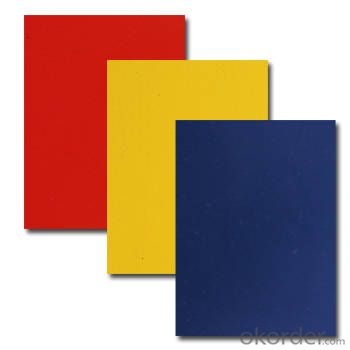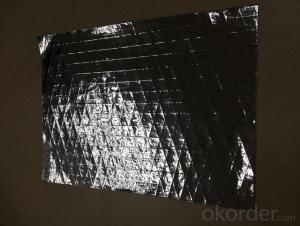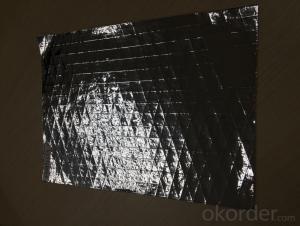8079 Aluminum Foil Facing Alloy for Ceiling Tiles
- Loading Port:
- Shanghai
- Payment Terms:
- TT OR LC
- Min Order Qty:
- 50 m.t.
- Supply Capability:
- 3000 m.t./month
OKorder Service Pledge
OKorder Financial Service
You Might Also Like
Specification
1. Structure of CC Aluminium in Coil Form for making Aluminium Circle Description
CC Aluminium in Coil Form for making Aluminium Circle is one semi-finished aluminium material. This coil can be rolled down to aluminium coil,sheet,circle ect. The alloy AA1050 is widly used in building, industry ect. Its weight is much lower than steel. So many customers choosed aluminium material instead of steel.
2. Specification of CC Aluminium in Coil Form for making Aluminium Circle


3. Application of CC Aluminium in Coil Form for making Aluminium Circle
(1).Interior: wall cladding, ceilings, bathrooms, kitchens and balconies, shutters, doors...
(2).Exterior: wall cladding, facades, roofing, canopies, tunnels,column covers , renovations...
(3).Advertisement: display platforms, signboards, fascia, shop fronts...
4. Feature of CC Aluminium in Coil Form for making Aluminium Circle
Surfact Quality :
Be free from Oil Stain, Dent, Inclusion, Scratches, Stain, Oxide Dicoloration, Breaks, Corrosion, Roll Marks, Dirt Streaks and other defect which will interfere with use,
Mechenical Property:
Chemical Composite and Mechanical Property
5. Certificate of CC Aluminium in Coil Form for making Aluminium Circle
SGS and ROHS(if client request, paid by client), MTC(plant provided), Certificate of Origin(FORM A, FORM E, CO), Bureau Veritas and SGS (if client request, paid by client), CIQS certificate
6. Image of CC Aluminium in Coil Form for making Aluminium Circle

7. Package and shipping of CC Aluminium in Coil Form for making Aluminium Circle
First, plastic cloth with drying agent inside; Second, Pearl Wool ; Third, wooden cases with dry agent , fumigation wooden pallets, aluminum surface could cover blue PVC film
8. FAQ
1) What is the delivery time?
Depends on actual order, around 20 to 35 days
2) What is the QC system:
We have QC staff of 20 persons and advanced equipment, each production is with MTC traced from Aluminum ingot lot.
3) What market do you mainly sell to?
Australia, America, Asia, Middle East, Western Europe, Africa etc
- Q: What specific cleaning procedures should be followed after using aluminum foil facing?
- <p>After using aluminum foil facing, there are a few special cleaning methods to consider. First, remove any leftover food or debris from the surface. If it's a reusable aluminum foil facing, gently wash it with warm soapy water and a soft sponge, avoiding abrasive materials that could scratch the surface. Rinse thoroughly and dry completely to prevent rust. For disposable foil, simply dispose of it according to local waste management guidelines. Avoid using harsh chemicals or extreme heat as they can damage the aluminum foil facing. Regular maintenance will ensure the longevity and hygiene of your aluminum foil facing.</p>
- Q: Is it possible to use aluminum foil as a surface for cooking pancakes?
- <p>While it's technically possible to cook a pancake on aluminum foil, it's not recommended. Aluminum foil is not designed for direct food contact at high temperatures, as it can potentially transfer aluminum to the food, which may be harmful. Additionally, the foil may not distribute heat evenly, leading to uneven cooking. Instead, use a non-stick pan or a griddle specifically designed for cooking pancakes to ensure even heat distribution and safe food preparation.</p>
- Q: Describe the optimal method for utilizing aluminum foil facing in cooking.
- <p>The best way to use aluminum foil facing for cooking is to preheat your oven and ensure the foil is shiny side up to reflect heat. For baking, create a tent with the foil to protect delicate foods from direct heat, which can prevent burning. When roasting, use foil to wrap foods like fish or vegetables to steam them, enhancing flavor and moisture retention. For grilling, use foil to create packets to cook foods indirectly or to line the grill to prevent food from sticking. Always handle with care to avoid tearing and ensure even heat distribution.</p>
- Q: This question asks about potential health or safety risks associated with the use of non-stick coatings on food covers or containers.
- <p>Non-stick coatings on food covers or containers are generally safe when used as directed. However, there are some concerns. High heat can cause these coatings to release potentially harmful fumes or chemicals, such as perfluorooctanoic acid (PFOA), which has been linked to health issues. It's important to avoid overheating non-stick items and to not use them in the oven or broiler. Always follow the manufacturer's guidelines for safe use and cleaning. If the coating is scratched or peeling, it's best to replace the item to prevent ingestion of the coating particles.</p>
- Q: What are the potential health advantages of using food packaging that does not contain aluminum?
- <p>Yes, there are health benefits associated with using aluminum-free food packaging. Aluminum has been linked to potential health risks, including Alzheimer's disease and neurological disorders. By avoiding aluminum in food packaging, there's a reduced risk of exposure to this metal, which can leach into food, especially when heated. This can help minimize the intake of aluminum, potentially lowering the risk of related health issues. Aluminum-free packaging also reduces the environmental impact and is often more sustainable, contributing to overall health by promoting a cleaner environment.</p>
- Q: Is it safe to use aluminum foil with a facing layer for storing salad dressings or oils?
- <p>Yes, it is generally safe to use aluminum foil facing for storing salad dressing or oil. Aluminum foil facing is designed to provide a barrier against air and moisture, which helps to keep the contents fresh. However, it's important to ensure that the foil is food-grade and that it does not have any sharp edges that could puncture the container. Additionally, it's best to store these items in a cool, dry place away from direct sunlight to maintain their quality and prevent spoilage.</p>
- Q: This question asks for advice on how to use aluminum foil effectively in the kitchen.
- <p>Using aluminum foil efficiently in the kitchen can save time and resources. Here are some tips: 1. Pre-cut and store: Keep a roll of aluminum foil in the kitchen and pre-cut pieces for quick use. 2. Double layer for insulation: Use a double layer for wrapping food to retain heat and keep food warm for longer. 3. Line baking sheets: Line baking sheets with foil to prevent sticking and make cleanup easier. 4. Cover dishes: Use foil to cover dishes in the oven to prevent over-browning. 5. Use for grilling: Wrap vegetables or fish in foil for easy, mess-free grilling. 6. Reuse: Reuse aluminum foil for multiple tasks to minimize waste. 7. Avoid overuse: Use only as much foil as needed to prevent unnecessary waste. 8. Recycle: Always recycle aluminum foil after use to contribute to sustainability.</p>
- Q: Is it possible to use aluminum foil with a shiny side as a non-stick surface for cooking purposes?
- <p>Yes, you can use aluminum foil facing as a non-stick surface for cooking. The shiny side of aluminum foil is often used to create a non-stick surface, which can be helpful when grilling or baking to prevent food from sticking to the pan or grill. However, it's important to use it properly to avoid any potential health risks. Ensure that the foil doesn't touch the heat source directly for extended periods, as this can cause the foil to break down and release aluminum into the food. It's also recommended to use heavy-duty aluminum foil for cooking to ensure it can withstand higher temperatures without puncturing or melting.</p>
- Q: Is it possible to use a single piece of aluminum foil for cooking or baking multiple times?
- <p>While aluminum foil is a versatile kitchen tool, it is not recommended to reuse a single piece of aluminum foil for cooking or baking multiple times. Aluminum foil can tear or become thin with use, which may compromise its effectiveness and potentially allow food to stick or contaminate the foil. Additionally, repeated use can lead to the accumulation of food particles and bacteria, posing a risk to food safety. It's best to use a fresh piece of aluminum foil for each cooking or baking session to ensure hygiene and椋熷搧瀹夊叏.</p>
- Q: This question asks for a method to create a facing made of aluminum foil.
- <p>To make your own aluminum foil facing, you'll need aluminum foil and a suitable adhesive. Start by cutting the aluminum foil to the desired size and shape. Apply a layer of adhesive to the back of the foil, ensuring it's evenly spread. Press the foil onto the surface you want to cover, smoothing out any bubbles or wrinkles. Use a knife or scissors to trim any excess foil. Allow the adhesive to dry completely before handling. This creates a reflective surface that can be used for insulation, decoration, or other purposes.</p>
Send your message to us
8079 Aluminum Foil Facing Alloy for Ceiling Tiles
- Loading Port:
- Shanghai
- Payment Terms:
- TT OR LC
- Min Order Qty:
- 50 m.t.
- Supply Capability:
- 3000 m.t./month
OKorder Service Pledge
OKorder Financial Service
Similar products
Hot products
Hot Searches
Related keywords




























